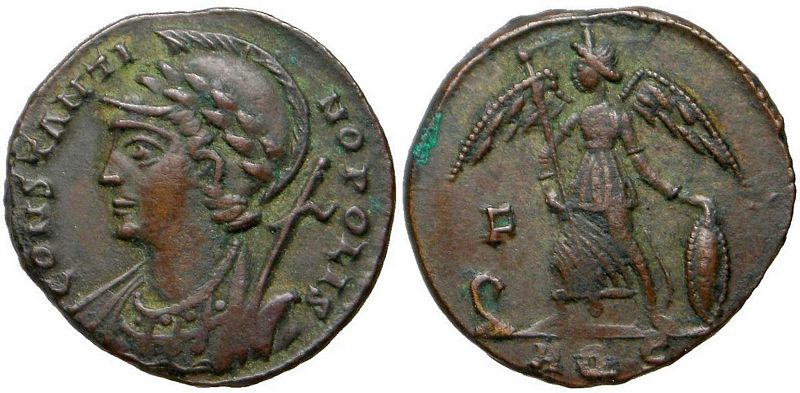The victory on a prow type alludes to the naval victory of Crispus and his subsequent capture of Byzantium (soon to be re-named Constantinople). Zosimus said that Constantine's fleet had 200 ships and Licinius had 350 ships. Zosimus might have exaggerated, but all sources agreed that Constantine's fleet was greatly outnumbered. What accounted for the surprise victory of Constantine's forces? Could it have been that Constantine had better trained sailors...maybe divine providence? A papyrus letter from circa A.D. 323, gives an answer. (C. H. Roberts, “A Footnote to the Civil War of A.D. 324.†Journal of Egyptian Archaeology 31 (1945) : 113.) The letter is from a procurator who said that the government of Egypt had an urgent requirement of box and acanthus wood for repair of the men-at-war vessels in the arsenals of Memphis and Babylon. Egypt sent a total of 130 ships to serve in the navy of Licinius, but it seems that they were all old tubs!
http://www.constantinethegreatcoins.com/comm/Thirteen mints produced these types: Trier, Lugdunum (Lyons), Arelate (Arles), Aquileia, Rome, Siscia, Thessalonica, Heraclea, Constantinople, Nicomedia, Cyzicus, Antioch and Alexandria.
The mints of Heraclea, Constantinople, Nicomedia and Cyzicus which surrounded the Propontis (the Sea of Marmara) dropped the S from the obverse legend. This is a regional variation and "reflects the fall of the terminal -s in the spoken language." ( J. P. C. Kent, “Urbs Roma and Constantinopolis: Medallions at the Mint of Rome.†Scripta Nummaria Roman. Essays Presented to Humphrey Sutherland. London: Spink & Son (1978) : 106.) The obverse legend break for all the mints is always CONSTAN-TINOPOLIS except for coins from Rome and one issue from Aquileia (see coin below), which used the legend break CONSTANTI-NOPOLIS .
Palladas, a fourth-century pagan poet, wrote mockingly about the city of Constantinople and coins with Victories on the prow --
"Here we are, the Victories, the laughing maidens, bearing victories to the Christ-loving city. Those who loved the city fashioned us, stamping figures appropriate to the victories." (Anth. Plan. 282)
A.D. 335-336
18mm 2.7 gm
Obv. CONSTANTI-NOPOLIS laureate, helmeted, wearing imperial mantle, holding scepter.
Rev. Victory stg. on prow, holding long scepter in r. hand, and resting l. hand on shield.
F left field, in ex. AQS
RIC VII Aquileia 137
